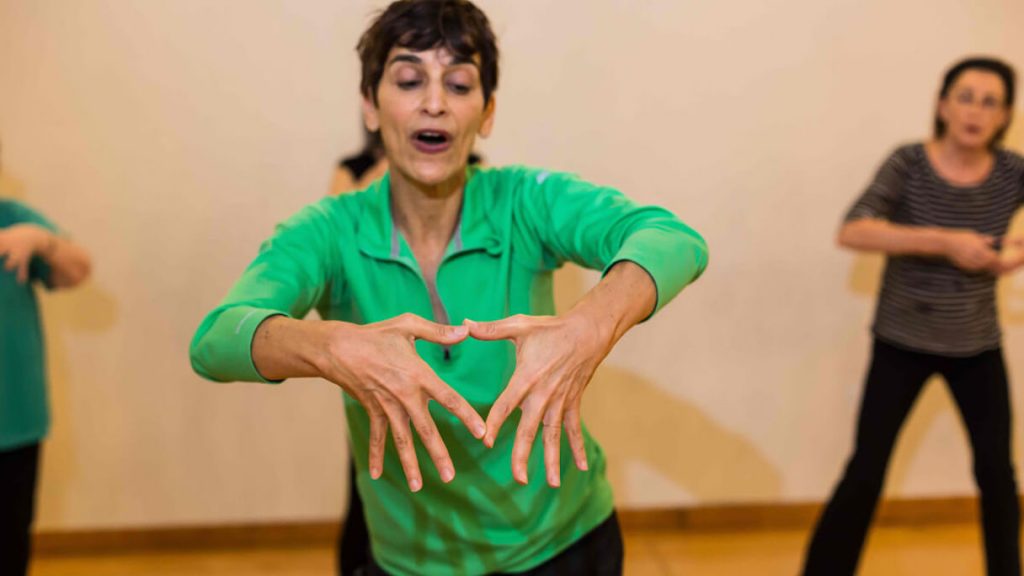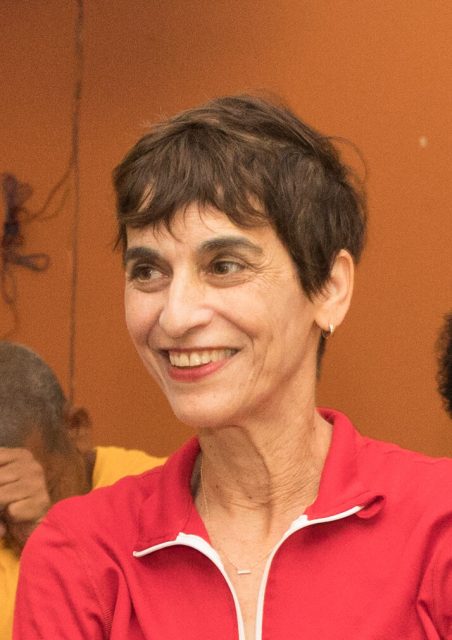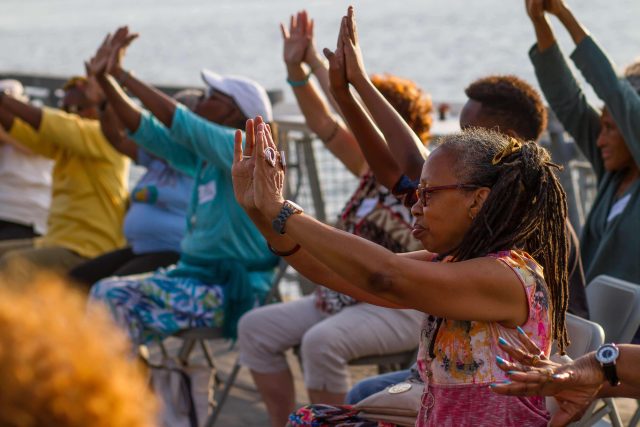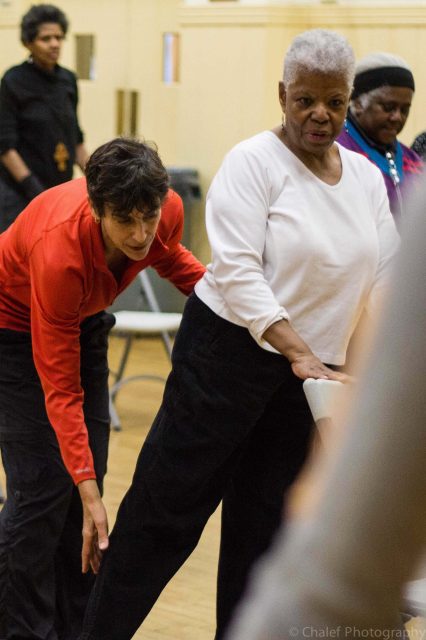
Instructor Naomi Goldberg Haas invites students to invent their own dance movements
By Deborah Quilter | Next Avenue
Part of the VITALITY ARTS SPECIAL REPORT
Pier I juts out over the Hudson River on Manhattan’s Upper West Side with — depending on your vantage point — mesmerizing views of the New York City skyline or New Jersey. As the waning sun hovered above the horizon, 16 older women wearing name tags waited for their Thursday dance class to begin. They didn’t seem to mind that the humidity felt like a sticky second shirt or that there was little breeze in the air.

Sitting in the middle of that circle was Naomi Goldberg Haas, the 57-year-old founder of Dances for a Variable Population (DVP), a program that offers free classes to older adults in the New York City area. Haas asked her assistant, teaching artist Rebecca Teicheira, to explain the rules to the students: Have fun and don’t do anything beyond your limits.
Then she hit the play button on Simon & Garfunkel’s 1966 classic 59thStreet Bridge Song (Feelin’ Groovy) and the students enthusiastically followed Haas through a seated warm-up where they lifted their legs, twisted their torsos and circled and snaked their arms, alternately reaching for the sky and swooping to the ground.
Haas then passed the baton to Teicheira, who seamlessly picked up leading the group. Participants also were invited to invent their own movements and lead the group themselves. Eventually everybody stood, split into two groups and had a Sharks-and-Jets style dance-off where they tried to outdo each other. This group was hardly hampered by self-consciousness; rather, they confidently strutted their stuff to one another and to the diners in a distant café.
In conversations after class, Haas and her students shared seven of the benefits of dancing, no matter what your age:
1. ‘You Recognize the Difference It Makes’
Haas explained her philosophy of teaching dance: “There’s so much we can learn from dancing with each other. Also, by dance-making with each other, we gain an appreciation of our own body and beauty.”
Some students come for the exercise benefits. “Once you pass a certain age, you realize you have to be in a physical program,” Haas observed. “You recognize the difference it makes. On a larger social level, the lack of movement is killing us.”
DVP, which Haas founded in 2008, works with more than 45 senior centers and institutions. Movement Speaks, one of its programs, offers older adults and low-income communities free dance instruction and a public performance of an original work created by class participants.

2. ‘Touch Is Life-giving’
While dance has health benefits for the body and mind, Haas emphasized that her goal is to inspire participants to move creatively and feel empowered by that movement.
DVP classes also incorporate some partner work where people might briefly hold hands as they circle around each other on the floor. “Touch with someone else is life-giving,” Haas explained.
At the end of class, the dancers divided themselves into groups of four. Each participant would lead a few times, then pass the torch to the next person, so everyone got a chance to create a movement and follow their partners.
Haas gazed on with affection as one group of students performed. “Beautiful,” she murmured.
3. You Can Rediscover Dance
Students who had previously studied dance might find the class more doable than a class they would find in a traditional studio because DVP’s emphasis is on what you can do, not insisting that people attempt choreography that would be beyond their limits.
Karen Beja, a 59-year-old school psychologist, began dancing with the group about three years ago. “I did a lot of dance as a young adult and I stopped in my late 30s and I miss it,” she explained. “Naomi has given me back movement.”
In addition to keeping her mobile and flexible, Beja said, “It makes me feel joyful.”

4. The Ability to Improvise and Memorize for a Better Brain
In many dance traditions, there is no improvisation, but more than one student noted how good the improvisational sections were for their minds. Indeed, science is discovering many benefits of dancing; having to remember the steps and combinations helps maintain mental muscles.
“In traditional dance, there’s not so much improvisation,” said Beja. “That was newer to me. Improv is really good for my brain. It’s fun.”
5. You Get a Chance to Diversify Your Social Circle
Beja also enjoys the diversity in the class. People come from different age groups, races, socio-economic backgrounds and they have different abilities.
“Maybe it’s because it’s not a heady or verbal group,” she said, “but it’s more about movement uniting everyone.” That kind of mixture sometimes doesn’t happen in life, but DVP provides this opportunity.
Another plus of this diversity, according to Beja, is that in the classes, she observes people who are much older than she is. “They are moving however they can at any age,” she said. This can inspire other participants to keep going because the older dancers set a positive example.
6. Making Connections with People and the Environment
A few students found that the class helps them form new friendships. Beja took part in a performance at Grant’s Tomb and noticed how much closer many class participants became as a result. “People were very connected,” she said.
And the outside class environment offers an additional boost. “It’s wonderful to be outdoors,” said Beja. “You feel part of the city.” Naturally occurring props in different venues can also become part of the dance, including barricades which are used as ballet barres, she added.
7. There Are Other Physical Benefits of Dance
Helga Busemann, a 70-plus former social worker who had been in physical therapy for her osteoporosis, felt that the dance class was more beneficial. “I like the enthusiasm,” she said. “In Naomi’s class, I get a full hour — and social support.”
Busemann once worked in a hospital setting and recalled seeing older patients who lived in sixth-floor walk-up apartments. “People came to rehab because they couldn’t handle the stairs — and they couldn’t handle their lives, either,” she said, adding that she realized, “it could be me.”
As many people age, a “fear of falling and fear of breaking arises,” Busemann noted. “When people break their hips, some people come back, and some people don’t. I don’t want to fall. [In the class], Naomi does a lot of balancing.”
For Busemann, exercise and movement are a must. “It’s like brushing your teeth. You have to do it. I need the exercise. I need the extra push of a class,” she said.
Demonstrating Their Skills
Once a year, students show what they’ve learned in class to friends and passers-by during a public performance. This can be a very special experience for the dancers.
Alice Ellerbeck, a 62-year-old psychotherapist, was part of a performance in the iconic Washington Square Park in Greenwich Village. “That was really exciting,” she recalled. Approximately 10 of her friends and family members came to watch.
“Anyone can dance. Everyone should dance,” Ellerbeck said.
![]() This article originally appeared on Next Avenue
This article originally appeared on Next Avenue
© Twin Cities Public Television - 2018. All rights reserved.
Read Next



